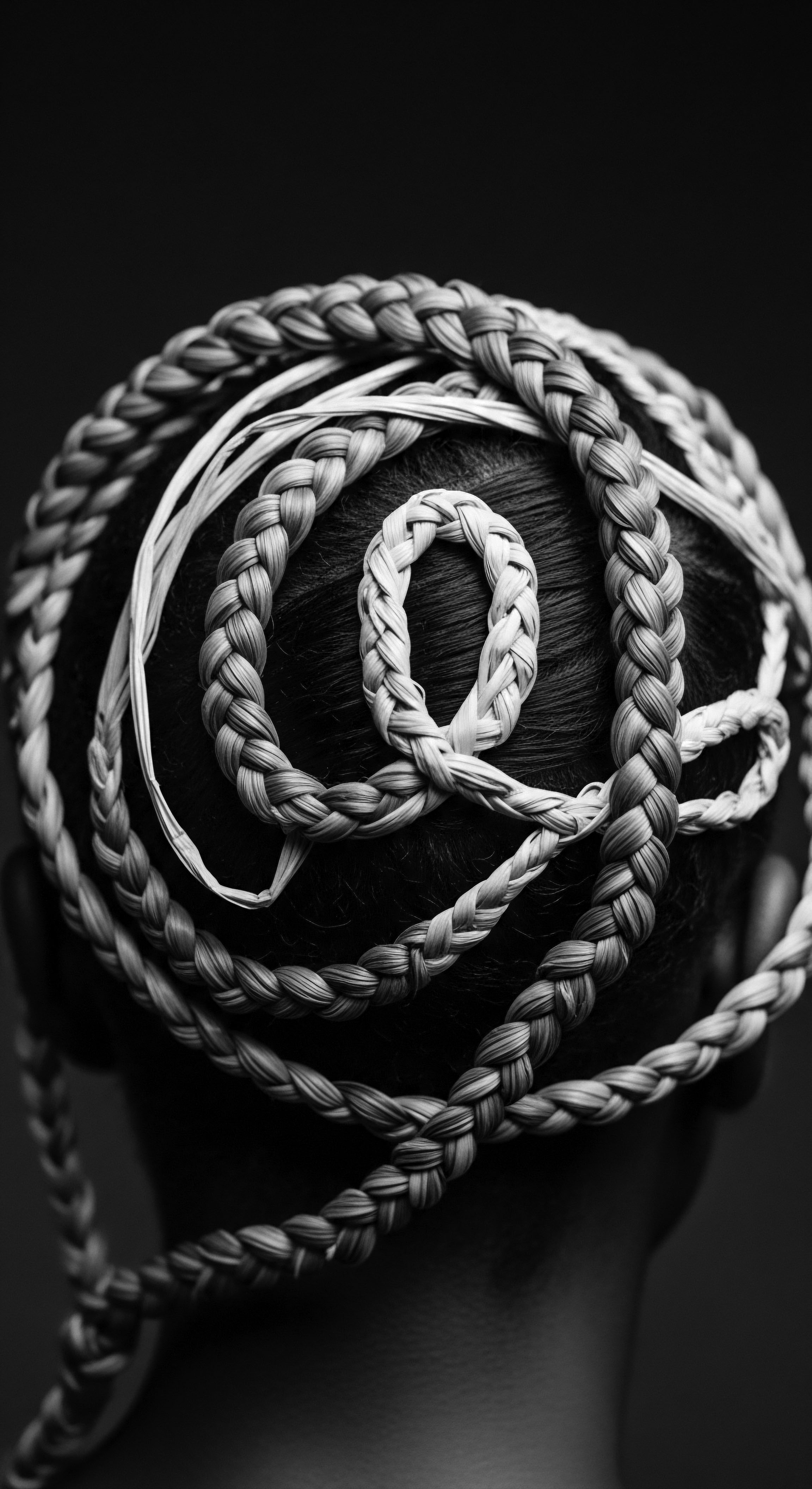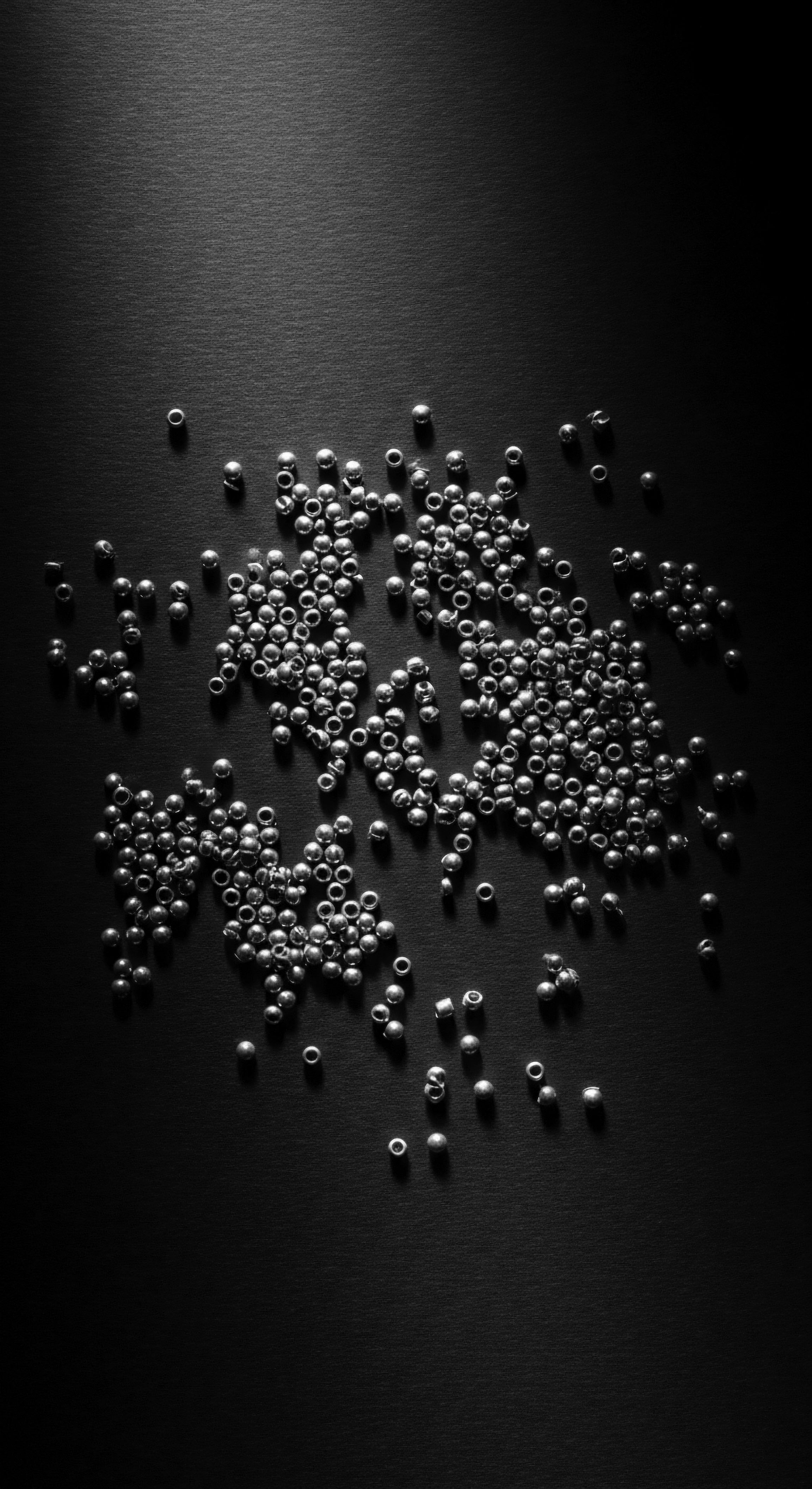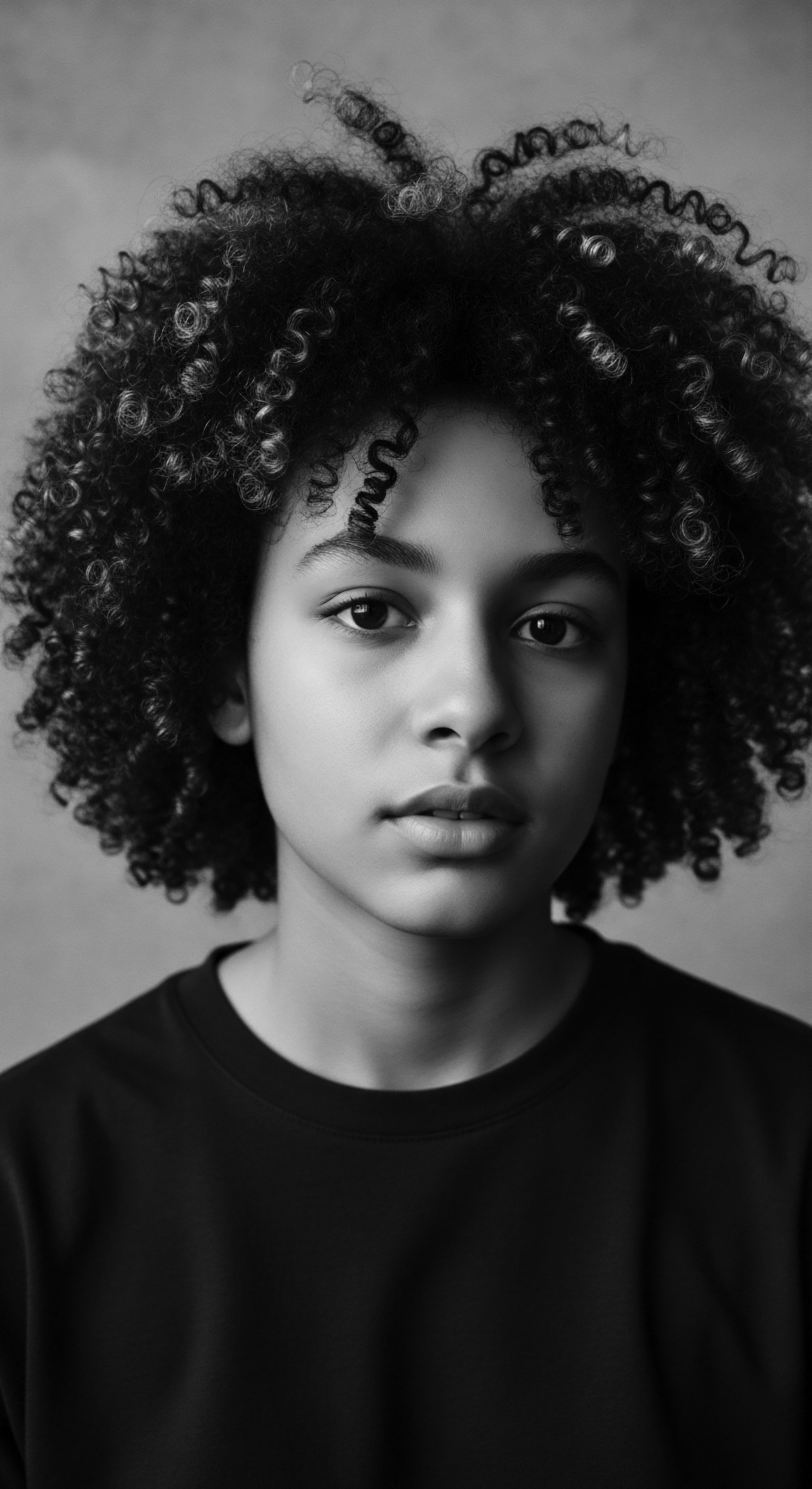
Roots
To stand at the threshold of textured hair is to stand at the edge of an ancient forest, where each strand, a twisted helix reaching for light, whispers tales of ages past. For those of us with hair that coils, kinks, and waves with a resilient spirit, its identity is not merely an aesthetic choice. It is a profound, living archive. Our hair is a direct, undeniable link to forebears, to the earth they walked upon, and to the wisdom they held in their hands and hearts, shaping their daily existence.
The very biology of textured hair, often seen through the limited scope of Western classification systems, possesses a deeper narrative, a heritage that speaks of adaptation and distinctiveness. The elliptical cross-section of a coily strand, for instance, differs markedly from the rounder form of straight hair. This unique shape influences how natural oils travel down the hair shaft, affecting moisture retention and demanding specific care. It is a biological signature, a genetic echo.
Ancestral understanding of these inherent qualities, though perhaps not articulated through the lens of modern molecular biology, certainly guided the practices of care and adornment. They recognized, in the very feel and behavior of the hair, its intrinsic need for replenishment and careful handling.
Ancestral comprehension of textured hair’s intrinsic needs, though uncodified by modern science, shaped practices of profound care and adornment, recognizing its unique biological signature.

Anatomy of a Living Connection
The intricate architecture of textured hair—its cuticle layers, the cortex, and the medulla—responds to the world in ways distinct to its form. The curl pattern, ranging from gentle waves to tight Z-patterns, presents more points of breakage along its journey from scalp to tip. This inherent characteristic, a biological gift and challenge, demanded ingenuity from our ancestors. They developed methods of manipulation and protection not born of scientific treatises, but from keen observation and generations of accumulated wisdom.
Think of the protective styles developed across the continent of Africa; these were not simply fashion statements. They were structural masterpieces, designed to shield vulnerable strands from environmental stressors, to retain precious moisture, and to minimize mechanical friction.
The naming conventions for hair types, now often reduced to numbers and letters, once held deeper cultural resonance. Indigenous communities possessed lexicons rich with descriptive terms for hair textures and states, terms that often connected hair to natural phenomena, spiritual concepts, or societal roles. These ancient words carried the weight of communal understanding, a heritage passed down through oral traditions, song, and touch. The way one’s hair behaved, its strength, its malleability, its capacity to hold a style—these qualities were understood within the fabric of daily life and social interaction.

Echoes in Classification
While contemporary systems like those attributed to Andre Walker attempt to categorize textured hair into numerical and alphabetical designations (e.g. 3A, 4C), our ancestors, across varied landscapes, had their own nuanced understandings. These traditional classifications were often less about precise curl circumference and more about how hair functioned within a particular ecosystem of life and belief.
They recognized hair that thrived in dry desert air versus hair that flourished in humid rainforests, discerning its properties through generations of trial and adaptation. This was practical ethnobotany and cosmetic science, passed down not through textbooks, but through the hands of elders teaching younger generations.
The language used to speak of hair often reflected its spiritual and social standing. In many West African societies, hair was regarded as the highest point of the body, a conduit to the divine, a spiritual antenna. The care afforded to it, the styles chosen, and the communal rituals surrounding its maintenance were therefore imbued with a sacred quality. This foundational understanding of hair as a living, sacred entity shaped every aspect of its daily interaction.
- Melanin ❉ The pigments providing color to hair, deeply connected to varied skin tones and sun protection strategies across ancestral lines.
- Keratin ❉ The fibrous protein forming hair, whose arrangement and bonding differ in textured hair, influencing its unique strength and elasticity.
- Follicle ❉ The root structure that determines hair shape; its curved or helical shape in textured hair causes the strand to coil from the scalp.

Ritual
The transition from a raw understanding of hair’s biological makeup to the daily practices of its care represents a seamless progression of ancestral wisdom . Here, the abstract knowledge of hair’s elemental properties takes on a tangible form, transforming into sacred rituals and enduring styling techniques. These are not mere aesthetic choices.
They are ceremonial acts, often communal, reinforcing social bonds, marking life stages, and acting as powerful statements of identity. The very act of styling textured hair became a repository of cultural memory, a living library of heritage .
Consider the expansive world of protective styling, a cornerstone of textured hair care. Braids, twists, and locs, so prevalent today, are direct descendants of ancient practices. Their purpose was manifold ❉ to guard delicate strands from the rigors of environment and daily activity, to preserve precious moisture, and, significantly, to convey intricate messages. For enslaved Africans in the Americas, this wisdom took on a powerful, subversive dimension.
The art of cornrowing, already a deep-rooted tradition, became a clandestine tool of resistance and a pathway to freedom. Patterns woven into the hair could serve as maps to escape routes, indicating pathways, waterways, or safe houses, while grains of rice or seeds were sometimes braided into the hair, carried secretly to be planted in new lands, ensuring survival (Byrd & Tharps, 2001). This profound act of resistance, embedded within the seemingly simple act of hair styling, speaks volumes about the ingenuity and resilience embedded in ancestral hair wisdom.

Styles as Sacred Symbols
The significance of braids extended far beyond utility. In many African societies, particular braided styles denoted marital status, age, tribal affiliation, wealth, or even readiness for spiritual rites. The meticulous crafting of each plait was a meditative practice, often performed by elders, fostering intergenerational connection and the transmission of knowledge.
The act of sitting to have one’s hair styled became a space for storytelling, for sharing wisdom, and for solidifying communal ties. This communal aspect of hair care, a true heritage of shared intimacy, distinguishes it from a solitary act of grooming.
The natural definition techniques so celebrated now—the wash-and-gos that allow coils to spring freely, the painstaking coiling of strands, the setting of waves—all echo a deeper understanding that the hair’s natural state is beautiful, worthy of celebration, and requires specific engagement. Ancestors recognized this inherent beauty, using natural substances to define, nourish, and protect these intricate patterns. Oils, clays, and plant extracts, sourced directly from the earth, were their elixirs, understood not just for their cosmetic properties, but for their spiritual and protective qualities.

Tools from the Earth
The toolkit of ancestral hair care was simple, yet remarkably effective, born from the resources of their immediate surroundings. Carved wooden combs, often adorned with symbolic imagery, served not only to detangle but to impart cultural meaning. Gourds or hollowed calabashes served as vessels for mixing potent botanical concoctions. The hands, themselves, became the primary tools—dexterous, intuitive, guided by generations of accumulated practice.
These tools, extensions of the human touch, were invested with the same reverence as the hair itself. Their modern counterparts, while perhaps more technologically advanced, seek to replicate the efficacy and gentle interaction that these ancestral instruments once provided.
| Ancestral Tool/Practice Carved Wooden Combs ❉ Often symbolic, used for detangling and creating intricate parts. |
| Modern Parallel/Influence on Identity Wide-Tooth Combs & Detangling Brushes ❉ Designed to reduce breakage, carrying forward the gentle approach to textured hair. |
| Ancestral Tool/Practice Natural Plant Fibers ❉ Used for extensions, weaving, and reinforcing styles. |
| Modern Parallel/Influence on Identity Synthetic & Human Hair Extensions ❉ Continue the tradition of protective styling and adornment, allowing diverse expressions of identity. |
| Ancestral Tool/Practice Communal Braiding Sessions ❉ Social gatherings, knowledge transfer, spiritual connection. |
| Modern Parallel/Influence on Identity Salon & Home Hair Care Spaces ❉ Still serve as places for community, shared beauty practices, and identity affirmation. |
| Ancestral Tool/Practice The evolution of hair tools reflects an unbroken lineage of care, rooted in the understanding that textured hair demands unique attention. |
The adoption of wigs and hair extensions, often viewed as a contemporary phenomenon, also holds deep historical roots . Ancient Egyptians, among others, utilized elaborate wigs not only for hygiene and protection from the sun but also as markers of status and power. These were not simply disguises.
They were constructions of identity, extensions of self. This historical context reveals a long tradition of augmenting and adorning hair, a practice that continues to allow for versatility and creative expression, particularly within Black and mixed-race communities, where hair has long been a site of both cultural expression and resistance.
Hair styling, from ancient braids to modern techniques, serves as a living language, expressing identity, transmitting cultural wisdom, and acting as a profound means of connection.

Relay
The enduring legacy of ancestral hair wisdom manifests not only in styling but, perhaps most critically, in the holistic care philosophies that define truly flourishing textured hair. The wisdom passed down through generations understood hair not in isolation, but as an integral part of the body, mind, and spirit—a microcosm reflecting the vitality of the whole. This comprehensive perspective, deeply rooted in heritage , connects ancient remedies with modern scientific validation, bridging centuries of observation with contemporary understanding.
The fundamental tenets of hair care—moisture, nourishment, and protection—were understood long before laboratories isolated specific compounds. Our ancestors, through trial and profound observation of their natural environments, identified plants, butters, and oils with remarkable properties. Think of shea butter, a staple across West Africa, known for its emollients that mimic the skin’s natural lipids, sealing in moisture and protecting the hair shaft.
Or the use of specific clays and herbs, like those found in traditional Ayurvedic practices in India, which cleansed the scalp gently while conditioning the hair. This was an applied science, honed by necessity and experience, now recognized for its efficacy by contemporary cosmetology.

How Do Ancient Practices Inform Modern Hair Regimens?
Building a personalized textured hair regimen today often involves elements that echo ancestral practices. The emphasis on gentle cleansing, deep conditioning, and protective styling aligns with the principles of minimal manipulation and maximal nourishment that have been passed down. For instance, the practice of “co-washing” (conditioning washing), a relatively modern term, mirrors ancient customs of using natural, non-stripping agents—often plant-based—to cleanse hair without depleting its vital moisture. The understanding that harsh detergents were detrimental was intuitive, born of experience with hair that required a tender touch.
The nighttime sanctuary for textured hair, so crucial in current care, has strong ancestral roots . The use of head wraps, scarfs, and bonnets, often crafted from silk or other smooth fabrics, was not merely a practical measure to preserve styles or prevent tangles. It carried cultural significance—a symbol of modesty, a sign of respect, or a means of guarding one’s spiritual essence during sleep. The bonnet, in its modern iteration, serves a practical purpose—reducing friction against harsh fabrics and retaining moisture—but it carries the silent weight of generations who understood the need for nightly protection, safeguarding both the physical hair and the spirit it adorned.
The deep dive into ingredients for textured hair needs reveals a consistent truth ❉ nature held many answers. Consider the widely celebrated Chebe powder, originating from the Basara Arab women of Chad. This blend of natural ingredients, applied to the hair and left for extended periods, aids in length retention and reduces breakage. Its historical use is not just anecdotal; it speaks to generations of empirical data collection within a specific community.
Modern science, while still studying its precise mechanisms, observes the tangible benefits of such long-standing, tradition-bound applications. The efficacy of these ancestral remedies often validates what was intuitively known for centuries.
- Shea Butter ❉ From the African shea tree, historically used for its deeply moisturizing and protective properties for skin and hair.
- Coconut Oil ❉ A traditional staple in many tropical regions, valued for its ability to penetrate the hair shaft and reduce protein loss.
- Aloe Vera ❉ Used across various ancient civilizations for its soothing, hydrating, and healing qualities for scalp and hair.

Holistic Influences on Hair Well-Being?
Ancestral wisdom consistently viewed well-being as a continuum, where physical health intertwined with spiritual and communal harmony. This holistic perspective is especially relevant to hair health. Dietary practices, often centered on nutrient-dense, locally sourced foods, contributed directly to the strength and vitality of hair.
Stress, both environmental and emotional, was understood to impact the body’s equilibrium, affecting everything from skin to hair. Communal practices—shared meals, storytelling, collective rituals—provided a social fabric that acted as a buffer against stress, fostering overall wellness that reflected in vibrant hair.
Problem-solving within ancestral hair care was often communal. When an individual faced issues like dryness or breakage, solutions were sought within the collective wisdom of the family or community. Elders, the repositories of this knowledge, offered guidance based on generations of inherited practices and remedies. This collective approach, where hair care was a shared responsibility and a source of collective pride, contrasts with the individualized, often isolated, pursuit of solutions in modern contexts.
The heritage of shared knowledge and mutual support underscores the profound community aspect of textured hair identity. This relational aspect of care reinforces that hair is never merely an object; it is a profound living connection.

Reflection
To contemplate the ways ancestral hair wisdom shapes textured hair identity is to embark on a journey that transcends mere appearance. It is a profound acknowledgment of continuity, a recognition that the helix of each strand carries the resonant echoes of untold generations. Our textured hair, in its myriad forms, is a living testament to resilience, an enduring symbol of a rich and often unwritten heritage . It speaks of survival, ingenuity, and beauty forged in the crucible of time and circumstance.
The lessons gleaned from ancient practices—the reverence for natural forms, the dedication to protection and nourishment, the communal bonds fostered through shared care—are not relics of a distant past. They are vital, pulsating truths that continue to guide contemporary expressions of textured hair identity. From the meticulous braiding of cornrows that once mapped pathways to freedom to the communal rituals of styling that cemented social ties, these acts have always been more than cosmetic. They are assertions of self, declarations of belonging, and expressions of an unbreakable spirit.
In every coil, every kink, every wave, there lies a story—a story of ancestral strength, of wisdom passed down through the hands and hearts of those who came before. This profound connection is the very ‘Soul of a Strand,’ a vibrant, breathing archive that reminds us that our hair is not just hair; it is a repository of history, a canvas for identity, and a profound bridge to our collective heritage . Its care is not a chore but a sacred dialogue with the past, a celebration of the present, and a hopeful declaration for the future.

References
- Byrd, A. D. & Tharps, L. L. (2001). Hair Story ❉ Untangling the Roots of Black Hair in America. St. Martin’s Press.
- Gittens, G. (2018). Afro-Textured Hair ❉ The Science and the History. Self-published.
- Mbiti, J. S. (1969). African Religions and Philosophy. Heinemann.
- Sachs, L. (1998). The Care and Feeding of the Black Hair ❉ A Guide to Proper Hair Care and Styling for Afro-Hair. Bantam Books.
- Akoto, Z. (2019). The Fundamentals of Natural Hair Care. Independently published.
- Walker, A. (1997). Andre Talks Hair. Simon & Schuster.
